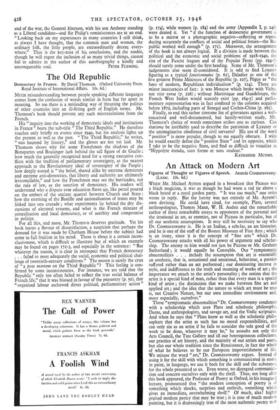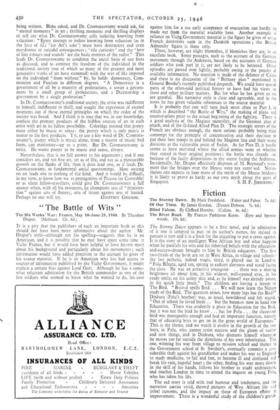An Attack on Modern Art
Figures of Thought or Figures of Speech. Ananda Coomaraswamy. (Luzac. 10s. 6d.)
WHEN Mr. Michael Ayrton argued in a broadcast that Picasso was a black magician, it was as though he had worn a red tie above a black beard at a royal garden party. " It was too much," one artist wrote in reply. But the heresy was not entirely of Mr. Ayrton's own devising. He could have cited, for example, Plato, several anthropologists, Thomas Mann, W. H. Auden and the remarkable author of these remarkable essays as opponents of the personal and the irrational in art, as enemies, not of Picasso in particular, but of all our aesthetic assumptions. It may still be necessary to say who Dr. Coomaraswamy is. He is an Indian, a scholar, an art historian, and he is one of the staff of the Boston Museum of Fine Arts ; which is an irony, since it is the concept of " fine arts " which Dr. Coomaraswamy attacks with all his power of argument and scholar- ship. The enemy to him would not just be Picasso or Mr. Graham Sutherland ; it would equally be, Constable. Our " symptomatic abnormalities . . . include the assumption that art is essentially an aesthetic, that is, sensational and emotional, behaviour, a passion suffered rather than an act performed ; our dominating interest in style, and indifference to the truth and meaning of works of art ; the importance we attach to the artist's personality ; the notion that the artist is a special kind of man, rather than that every man is a special kind of artist ; the distinction that we make between fine art and applied art ; and the idea that the nature to which art must be true is, not Creative Nature, but our own immediate environment and, more especially, ourselves."
These "symptomatic abnormalities" Dr. Coomaraswamy condemns with a scholarship which uses Plato and scholastic philosophy, Dante, and anthropologists, and savage art, and the Vedic scriptures. And when he says that " Plato knew as well as the scholastic philo- sophers that the artist as such has no moral responsibilities, and can only sin as an artist if he fails to consider the sole good of the work to be done, .whatever it may be," he assaults not only the Arts Council, the Tate Gallery and all our heterogeneous collections, our practice of art history, and the majority of our artists and poets, but also our whole tradition since the Renaissance, in fact the whole of what he believes to be our European impoverishment of life. We misuse the word "art," Dr. Coomaraswamy argues. Instead of using it for the skill with which something is communicated in stone, in paint, in language, we use it both for the skill and the substance, for the whole presented to us. Even worse, we disregard communica- tion and concern ourselves only with the thrill. Thus, not long after this book appeared, the Professor of Poetry at Oxford, in his inaugural lecture, pronounced that " the modern conception of poetry is of something which shocks, surprises and enthrals, something which gives an immediate, overwhelming thrill." Of much, alas I highly praised modern poetry that may be true ; it is true of much modern painting, but it is decreasingly true of the most authentic poetry now ,
being written. Blake asked, and Dr. Coomaraswamy would ask, for " eternal moments " in art ; thrilling .moments and thrilling displays of self are what Dr. Coomaraswamy calls isolating knowing from valuation: " Every attempt to isolate knowing from valuation (as in The love of Aar ' for Art's sake ') must have destructive and even murderous or suicidal consequences ; ' vile curiosity ' and the ' love of fine colours and sounds' are the basic motives of the sadist." This leads Dr. Coomaraswamy to condemn the social basis of our lives as diseased, and to contrast the freedom of the individual in the traditional society (out of which so many of the greatest and most generative works of art have stemmed) with the way of life imposed on the individual " from without " by, he holds democracy, Com- munism and Fascism in different degrees. " A Democracy is a government of all by a majority of proletarians, a soviet a govern- ment by a small group of proletarians, and a Dictatorship a government by a single proletarian."
In Dr. Coomaraswamy's traditional society, the artist was indifferent to himself, indifferent to thrill, and sought the expression of eternal moments out of those eternal principles on which the order of the society was based. And I think it is true that we, in our knowledge, confuse the primary products of the hidden sources of art in each artist with art in its fullest possibility. Coleridge insisted that poetry must either be music or sense: the poetry which is only music is nearer to the first products. Yet, to use a key word of Dr. Coomara- swamv's, poetry which is music alone, from a master of music 'and form, can ministrate—up to a point. But Dr. Coomaraswamy is strict. He wants poetry to be music and sense, always. - Nevertheless, that is no full answer to his arguments ; and if one considers art, and not fine art, art as of life, and not as a pleasurable growth on the flanks of life, then it does lead one, as it leads Dr. Coomaraswamy, to fundamental social questionings. Most writing on art leads one to nothing of the kind. And it would be difficult, in my view, to know how we as protagonists of Picasso (or Constable) or as silent fellow-travellers, could give Dr. Coomaraswamy a full answec when, with all his resources, he champions arts of "ministra- tion " against arts of flattery, arts of intent against arts of hazard.































 Previous page
Previous page